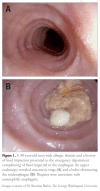Emerging therapeutic options for eosinophilic esophagitis
- PMID: 24803874
- PMCID: PMC4011375
Emerging therapeutic options for eosinophilic esophagitis
Abstract
Eosinophilic esophagitis (EoE) is a chronic inflammatory condition of the esophagus that often occurs in atopic persons. Management strategies include pharmacotherapy, dietary modification, and endoscopic therapy, although patients will often have a relapsing and remitting course. Currently, the primary pharmacotherapy for EoE consists of corticosteroids. Immuno-modulators, leukotriene antagonists, biologies, and monoclonal antibodies are currently under study for treatment of EoE. The role of immunoglobulin E-mediated allergic reactions has been well documented and may provide insight into the etiology and effective therapy of EoE.
Keywords: Eosinophilic esophagitis; proton pump inhibitor—responsive esophageal eosinophilia; reflux esophagitis.
Figures




References
-
- Liacouras CA, Furuta GT, Hirano I, et al. Eosinophilic esophagitis: updated consensus recommendations for children and adults. J Allergy Clin Immunol. 2011;128(1):3–20.e6. quiz21-22. - PubMed
-
- Dellon ES, Gonsalves N, Hirano I, Furuta GT, Liacouras CA, Katzka DA. American College of Gastroenterology. ACG clinical guideline: evidence-based approach to the diagnosis and management of esophageal eosinophilia and eosinophilic esophagitis (EoE) Am J Gastroenterol. 2013;108(5):679–692. quiz 693. - PubMed
-
- Straumann A, Simon HU. Eosinophilic esophagitis: escalating epidemiology? Allergy Clin Immunol. 2005;115(2):418–419. - PubMed
-
- Arias A, Lucendo AJ. Prevalence of eosinophilic oesophagitis in adult patients in a central region of Spain. Eur J Gastroenterol Hepatol. 2013;25(2):208–212. - PubMed
-
- Hruz P, Straumann A, Bussmann C, et al. Swiss EoE study group. Escalating incidence of eosinophilic esophagitis: a 20-year prospective, population-based study in Olten County, Switzerland. J Allergy Clin Immunol. 2011;128(6):1349–1350.e5. - PubMed
